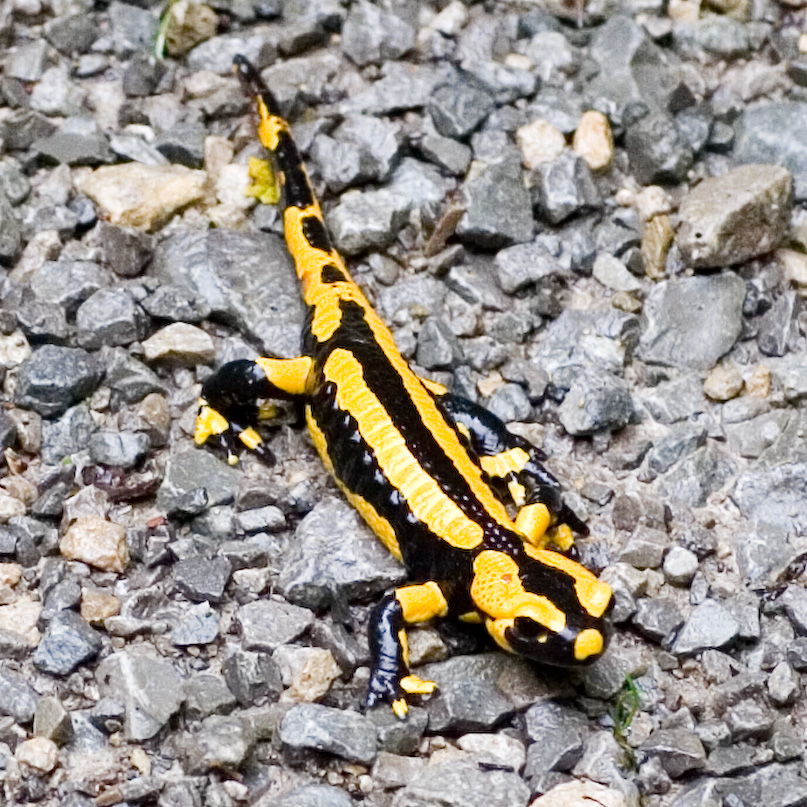- Fire Salamander
Taxobox
name = Fire Salamander
status = LC | status_system = IUCN3.1
trend = down

image_width = 230px
regnum =Animal ia
phylum = Chordata
classis =Amphibia
ordo =Caudata
familia =Salamandridae
genus = "Salamandra "
species = "S. salamandra"
binomial = "Salamandra salamandra"
binomial_authority = (Linnaeus, 1758)The Fire Salamander ("Salamandra salamandra") is probably the most well-known
salamander species inEurope . It is black with yellow spots or stripes to a varying degree; some specimens can be nearly completely black while on others the yellow is dominant. Shades of red and orange may sometimes appear, either replacing or mixing with the yellow according to subspecies. Fire Salamanders can have a very long lifespan. In the German natural history museum ofAlexander Koenig a salamander lived for more than 50 years Fact|date=July 2008.Habitat, diet, and Other
Fire Salamanders live in forests in the hilly parts of southern and central Europe. They prefer deciduous forests, as they like to hide in the fallen leaves, but also at mossy tree trunks. They need clean small brooks in their habitat for the development of the larvae. Whether on land or in water, fire salamanders are inconspicuous. They spend much of their time hidden beneath stones, wood or other objects.
Fire Salamanders are active in the evening and the night, but on rainy days they are active in daytime as well. Their diet consists of various insects, spiders, earthworms and slugs, but they also occasionally eat small vertebrates like newts and young frogs. Small prey will be caught within the range of the vomerine teeth or by the posterior half of the tongue, which adheres the prey. The fire salamander can grow to around 8 inches.
Reproduction
Males and females look very similar except during the breeding season, when the most conspicuous difference is a swollen gland around the male's vent. This gland produces the spermatophore, which carries a sperm packet at its tip. The courtship happens on land. After the male becomes aware of a potential mate, he confronts her and blocks her path. The male deposits his spermatophore on the ground. Reproduction occurs by means of this spermatophore, which will be taken up by the female. Their gills develop lungs.
Neotenic fire salamanders have not been observed.Toxicity
Salamanders may actively defend themselves once they are grasped by a predator. Besides various antipredator postures, "S. salamandra" adults are able to extrude heavy toxic skin secretions, e.g. the neurotoxic
alkaloid Samandarin . This alkaloid causes strong muscle convulsions and high-blood pressure combined withhyperventilation in all vertebrates. The poison glands of the Fire salamander are concentrated in certain areas of the body, especially around the head and the dorsal skin surface. The colored portions of the animal's skin usually coincide with these glands. Most of these secretions might be effective against bacterial and fungal infections of the epidermis, but some secretions could also be dangerous to human life.
=Distribution= Fire Salamanders are found in most of southern and central Europe. They are most commonly found at altitudes between 400 and 1000 m, only rarely below (in Northern Germany sporadically down to 25 m). However on the Balkan or in Spain they are commonly found in higher altitudes as well.Nominae Herpetofaunae Europaeae:
"Salamandra salamandra" (Linnaeus, 1758)
*
England - Fire salamander, Spotted salamander
*France - Salamandre commune
*Spain - Salamandra común
*Germany - Feuersalamander
*Portugal - Salamandra-de-fogo, Salamandra comum, Salamandra-de-pintas-amarelas
*Italy - Salamandra pezzata
*Netherlands - Vuursalamander
*Norway - Ildsalamander
*Slovenia - Navadni močerad
*Croatia - Pjegavi daždevnjak
*Serbia - Šare ni daždevnjak
*Hungary - Foltos szalamandra
*Poland - Salamandra plamista
*Romania - Salamandra comuna
*Lebanon - Fire salamander, Spotted salamander (Altitude: 1800m)
*Israel - סלמנדרה כתומה
*Czech Republic - Mlok skvrnitýubspecies
Several subspecies of the Fire Salamander are recognized. Most notable are the subspecies "fastuosa" and "bernadezi", which are the only
viviparous subspecies - the others are ovoviviparous.
*"S. s. alfredschmidti"
*"S. s. almanzoris" - Spotted Fire Salamander
*"S. s. bejarae" (or "hispanica")
*"S. s. bernardezi" (extinct?)
*"S. s. beschkovi"
*"S. s. crespoi"
*"S. s. fastuosa" (or "bonalli") - Yellow Striped Fire Salamander
*"S. s. gallaica" - Portuguese Fire Salamander
*"S. s. gigliolii"
*"S. s. infraimmaculata"
*"S. s. longirostris" - Los Barrios Fire Salamander
*"S. s. morenica"
*"S. s. salamandra" (or "werneri")
*"S. s. semenovi"
*"S. s. terrestris" - Barred Fire SalamanderGallery
References
* Database entry includes a range map and justification for why this species is of least concern
External links
* [http://research.amnh.org/herpetology/amphibia/names.php?&taxon=salamandra+salamandra Amphibian Species of the World]
* [http://www.caudata.org/cc/species/Salamandra/Salamandra_sp.shtml Caudata.org entry for Salamandra]
* [http://www.schwanzlurche.de Caudatamedia]
Wikimedia Foundation. 2010.
